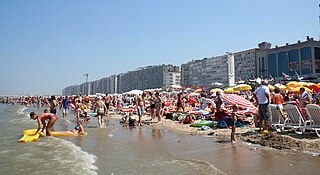
Blankenberge is a city and a municipality in the Belgian province of West Flanders. The municipality comprises the town of Blankenberge proper and the settlement of Uitkerke.
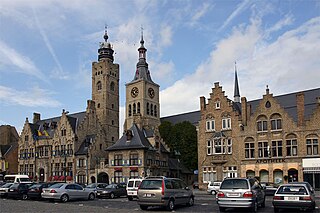
Diksmuide is a Belgian city and municipality in the Flemish province of West Flanders. The municipality comprises the city of Diksmuide proper and the former communes of Beerst, Esen, Kaaskerke, Keiem, Lampernisse, Leke, Nieuwkapelle, Oostkerke, Oudekapelle, Pervijze, Sint-Jacobs-Kapelle, Stuivekenskerke, Vladslo and Woumen.

Ostend is a coastal city and municipality, located in the province of West Flanders in the Flemish Region of Belgium. It comprises the boroughs of Mariakerke, Raversijde, Stene and Zandvoorde, and the city of Ostend proper – the largest on the Belgian coast.

Roeselare is a Belgian city and municipality in the Flemish province of West Flanders. The municipality comprises the city of Roeselare proper and the towns of Beveren, Oekene and Rumbeke.

Poperinge is a city and municipality located in the Belgian province of West Flanders, Flemish Region, and has a history going back to medieval times. The municipality comprises the town of Poperinge proper and surrounding villages. The area is famous for its hops and lace.

Zonnebeke is a municipality located in the Belgian province of West Flanders. The municipality comprises the villages of Beselare, Gheluvelt, Passendale, Zandvoorde and Zonnebeke proper. On January 1, 2006, Zonnebeke had a total population of 11,758. The total area is 67.57 km2 which gives a population density of 174 inhabitants per km2.

Zeelandic Flanders is the southernmost region of the province of Zeeland in the south-western Netherlands. It lies south of the Western Scheldt that separates the region from the remainder of Zeeland and the Netherlands to the north. Zeelandic Flanders is bordered to the south and to the east by Belgium.

Sittard is a city in the Netherlands, situated in the southernmost province of Limburg.

The Yser Towers are a monument complex near the Yser river at Diksmuide, West Flanders in Belgium. The first tower was built in 1928–30 to commemorate the Belgian soldiers killed on the surrounding Yser Front during World War I and as a monument to Christian pacifism. However, it subsequently became an important political symbol for the Flemish Movement and was destroyed in 1946 as a result of its association with Flemish nationalist collaboration in German-occupied Belgium in World War II. The current tower was rebuilt alongside the remains of the original and copied its design. It was finished in 1965. It remains a site of political significance to Flemish nationalists and is the center for their annual Yser Pilgrimage (IJzerbedevaart).

The Groeningemuseum is a municipal museum in Bruges, Belgium, built on the site of the medieval Eekhout Abbey.

Fort Breendonk is a former military installation at Breendonk, near Mechelen, in Belgium which served as a Nazi prison camp (Auffanglager) during the German occupation of Belgium during World War II.

Ostend–Bruges International Airport, commonly known simply as Ostend Airport, is an international airport located 2.7 nautical miles south southwest of Ostend, West Flanders in the Flemish Region of Belgium, near the coast and about 25 km (16 mi) from the city centre of Bruges. Although freight transport is the focus of a large proportion of its activities, the airport is increasingly used for passenger flights, mainly charter and holiday flights organised by tour operators. It is also often used for private business flights.

Loppem Castle is a mansion situated in Loppem in the municipality of Zedelgem, near Bruges in West Flanders, in the Flemish Region of Belgium.
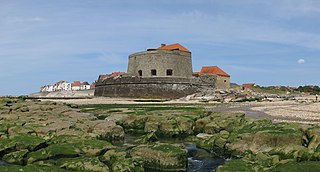
Ambleteuse is a commune in the Pas-de-Calais department in northern France.
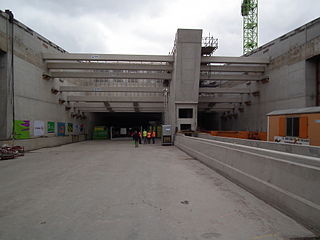
The Second Coen Tunnel is a tunnel under the North Sea Canal, next to the Coen Tunnel in Amsterdam. The tunnel was built in combination with a new highway connection, the Westrandweg, to the A5 motorway. The tunnel consists of 3 fixed lanes and two reversible lanes, which are opened in the direction where traffic is the heaviest. The goal of the Second Coen Tunnel is to lighten congestion which occurs before the original Coen Tunnel on the A8 motorway in the morning and the A10-West motorway in the evening. This greatly increases the accessibility of Amsterdam from the north of the Netherlands.

Fort Napoleon in Ostend is a polygonal fort built in the Napoleonic era. It has recently been restored and is open to the public.

The Atlantic Wall Open Air Museum is a military museum near Ostend in Belgium which preserves fortifications of the Atlantic Wall dating to the First and Second World Wars. The section of fortifications owned by the museum - over 60 bunkers and two miles of trenches - is among the best preserved sections of the defensive line in Europe. The fortifications survive because they were built on land belonging to Prince Charles, Count of Flanders who decided that they should not be destroyed after the war, but be kept as a national monument.

The history of Belgium in World War I traces Belgium's role between the German invasion in 1914, through the continued military resistance and occupation of the territory by German forces to the armistice in 1918, as well as the role it played in the international war effort through its African colony and small force on the Eastern Front.
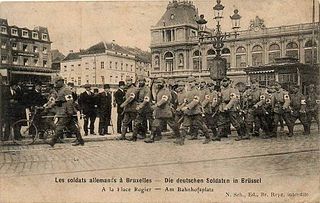
The German occupation of Belgium of World War I was a military occupation of Belgium by the forces of the German Empire between 1914 and 1918. Beginning in August 1914 with the invasion of neutral Belgium, the country was almost completely overrun by German troops before the winter of the same year as the Allied forces withdrew westwards. The Belgian government went into exile, while King Albert I and the Belgian Army continued to fight on a section of the Western Front. Under the German military, Belgium was divided into three separate administrative zones. The majority of the country fell within the General Government, a formal occupation administration ruled by a German general, while the others, closer to the front line, came under more repressive direct military rule.

The Lange Max Museum (LMM) is devoted to the German 38 cm SK L/45 "Max" gun and the German occupation of Koekelare and the nearby area in World War I. The focus on the German side of the war makes it a unique museum in Belgium. The museum is named after the nickname of the German gun "Lange Max", which was one of the biggest guns in the world in 1917, and is located in Koekelare.





















